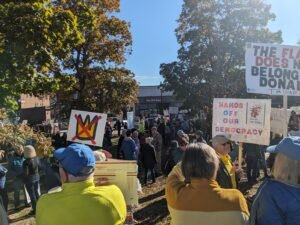
August 3, 2018; Dallas Morning News
Dallas Area Habitat for Humanity, the back-to-back Habitat International Affiliate of the Year winner of 2011–2012 and one of the Dallas Metro’s largest developers, has found itself in dire financial straits.
According to the Dallas Morning News, “Dallas Habitat has been swimming in red ink for at least three years, losing $2.3 million in 2016 and $2.6 million in 2015,” and was forced to bring in a new CEO, David Crawford, to get things back on track. So far, Crawford has taken confident, drastic steps to do so, including firing Cyndy Lutz, longtime vice president of neighborhood investment, and putting the organization’s current headquarters in desirable West Dallas on the market. What’s still unclear, however, is what exactly led to these troubles; how does a group go from making a record-setting $15.4 million in 2011 to losing nearly a fifth of that just six years later?
In November of 2011, Dallas mayor Mike Rawlings announced Habitat’s amazingly ambitious “$100 million plan to revitalize five of the city’s poorest neighborhoods”: Bonton, Joppa, West Dallas, South Dallas, and the Lancaster Transportation Corridor. They wouldn’t just build homes; a local CBS station reported that Habitat would “also be buying land and properties that have become a nuisance, in hopes to use that space for military veterans and senior citizens.” The “Dream Dallas” plan, is, to date, the largest investment to have ever been made in those impoverished areas and, as a result, it needed a significant amount of funding. Thus, the mayor “urged the public to pitch in by donating”—after all, $100 million is a very pretty penny.
At first glance, it would appear that his call to action had worked. By looking at Habitat’s Form 990s for its most successful years, it can be seen that the affiliate pulled in $25.6 million in 2011 and $21.8 million in 2012 from contributions alone. Those donations, once combined with the selling of built properties—at $8.2 million and $18.1 million, respectively—allowed the group to be able to maintain a war chest of $33.4 million in 2012, even after racking up expenses of over $20 million.
Sign up for our free newsletters
Subscribe to NPQ's newsletters to have our top stories delivered directly to your inbox.
By signing up, you agree to our privacy policy and terms of use, and to receive messages from NPQ and our partners.
It can be seen though, that the contribution numbers are somewhat misleading. While private individuals and groups did donate a solid amount—$6.8 million and $8.7 million for 2011 and 2012, respectively—the lion’s share of what was given to Habitat was in the form of government grants. The origin of most of these funds can be traced to the federal Neighborhood Stabilization Program (NSP), which was a part of 2008’s Housing and Economic Recovery Act, put in place to combat the effects of the Great Recession on communities across the country. Dallas Habitat was given $28,954,259, which corresponds with a sizable portion grant amount seen in the 990s over the period from 2010–2013, as a part of “NSP2,” or the second round of NSP funding authorized by the American Recovery and Reinvestment Act, more commonly known as Obama’s stimulus package.
$28 million can certainly go a long way, especially for a group like Habitat for Humanity. A study by Southern Methodist University’s Cox School of Business found that for every dollar invested by Habitat, the targeted neighborhood “[generated] $3 of economic activity.” As the saying goes, however, the devil is in the details. According to Habitat’s “NSP2” grant description, they were required to build “at least 250 new homes [with] titles transferred by Nov. 11, 2013,” three years after the receipt of the grant. This meant that the group, which was used to building slightly fewer than 50 houses a year, was being forced to nearly double their production output, moving from an all-volunteer force to one that contracted labor as well. They took this challenge in stride and thus added to their plate the aforementioned “Dream Dallas” plan, and by the beginning of 2016, according to the Dallas Morning News, they had “built 534 homes and refurbished 395.”
But that decision is the one that sunk them. In deciding to go forward with Dream Dallas, Habitat Dallas was acting as if its free-flowing spigot of government money would never be turned off. In 2013, the first year that they found themselves in the red, it was. Despite that strong warning sign, they continued to build as if it were directly after the recession and they were still being subsidized, successfully creating many beautiful new properties but finding that they couldn’t sell them all off.
A key challenge that Habitat found was that it was “difficult to sell homes in distressed infill neighborhoods when buyers prefer to purchase homes in subdivisions.” The proceeds from this activity make up a very large portion of the group’s revenue, so when their program services revenue plunged from its high of $18.1 million in 2012 to a rock bottom of $1.8 million in 2014, the nonprofit really felt the blow.
The new CEO’s confidence has some merit to it, though. Despite its affordability in previous years, the Dallas-Fort Worth area is currently experiencing a 20,000 housing unit shortage, meaning that families need housing. With some much needed luck (read: heavy prayer), Habitat should be able to sell off many of its units and make the cutbacks necessary to keep them afloat.—Moshe Hecht
This article’s content has been changed from its initial release.











